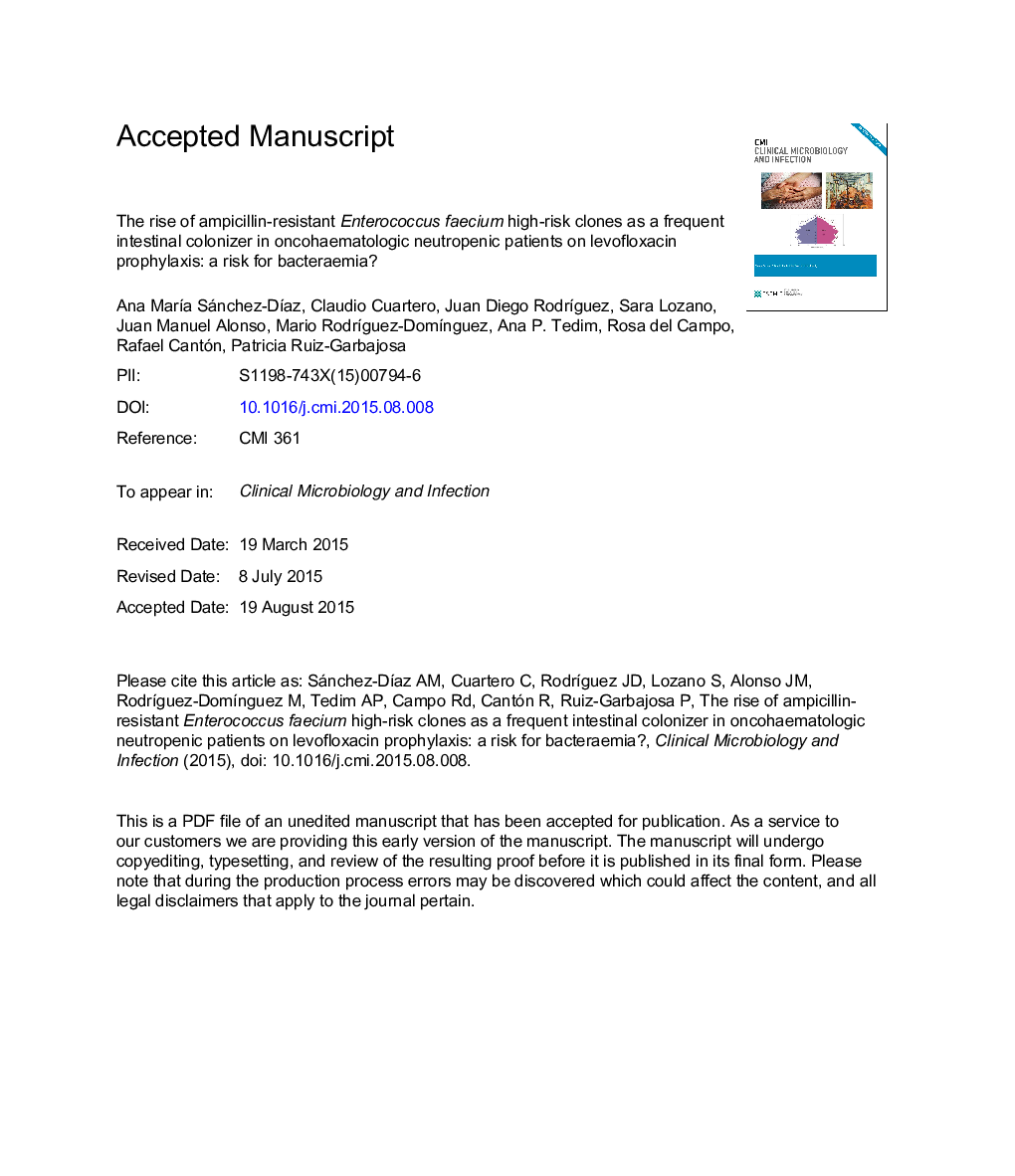| کد مقاله | کد نشریه | سال انتشار | مقاله انگلیسی | نسخه تمام متن |
|---|---|---|---|---|
| 6129078 | 1222150 | 2016 | 26 صفحه PDF | دانلود رایگان |
عنوان انگلیسی مقاله ISI
The rise of ampicillin-resistant Enterococcus faecium high-risk clones as a frequent intestinal colonizer in oncohaematological neutropenic patients on levofloxacin prophylaxis: a risk for bacteraemia?
دانلود مقاله + سفارش ترجمه
دانلود مقاله ISI انگلیسی
رایگان برای ایرانیان
کلمات کلیدی
موضوعات مرتبط
علوم زیستی و بیوفناوری
ایمنی شناسی و میکروب شناسی
میکروب شناسی
پیش نمایش صفحه اول مقاله

چکیده انگلیسی
Levofloxacin extended prophylaxis (LEP), recommended in oncohaematological neutropenic patients to reduce infections, might select resistant bacteria in the intestine acting as a source of endogenous infection. In a prospective observational study we evaluated intestinal emergence and persistence of ampicillin-resistant Enterococcus faecium (AREfm), a marker of hospital adapted high-risk clones. AREfm was recovered from the faeces of 52 patients with prolonged neutropenia after chemotherapy, at admission (Basal), during LEP, and twice weekly until discharge (Pos-LEP). Antibiotic susceptibility, virulence traits and population structure (pulsed-field gel electrophoresis and multilocus sequence typing) were determined and compared with bacteraemic isolates. Gut enterococcal population was monitored using a quantitative PCR quantification approach. AREfm colonized 61.4% of patients (194/482 faecal samples). Sequential AREfm acquisition (25% Basal, 36.5% LEP, 50% Pos-LEP) and high persistent colonization rates (76.9-89.5%) associated with a decrease in clonal diversity were demonstrated. Isolates were clustered into 24 PFGE-patterns within 13 sequence types, 95.8% of them belonging to hospital-associated Bayesian analysis of population structure subgroups 2.1a and 3.3a. Levofloxacin resistance and high-level streptomycin resistance were a common trait of these high-risk clones. AREfm-ST117, the most persistent clone, was dominant (60.0% isolates, 32.6% patients). It presented esp gene and caused 18.2% of all bacteraemia episodes in 21% of patients previously colonized by this clone. In AREfm-colonized patients, intestinal enrichment in the E. faecium population with a decline in total bacterial load was observed. AREfm intestinal colonization increases during hospital stay and coincides with enterococci population enrichment in the gut. Dominance and intestinal persistence of the ST117 clone might increase the risk of bacteraemia.
ناشر
Database: Elsevier - ScienceDirect (ساینس دایرکت)
Journal: Clinical Microbiology and Infection - Volume 22, Issue 1, January 2016, Pages 59.e1-59.e8
Journal: Clinical Microbiology and Infection - Volume 22, Issue 1, January 2016, Pages 59.e1-59.e8
نویسندگان
A.M. Sánchez-DÃaz, C. Cuartero, J.D. RodrÃguez, S. Lozano, J.M. Alonso, M. RodrÃguez-DomÃnguez, A.P. Tedim, R. del Campo, J. López, R. Cantón, P. Ruiz-Garbajosa,